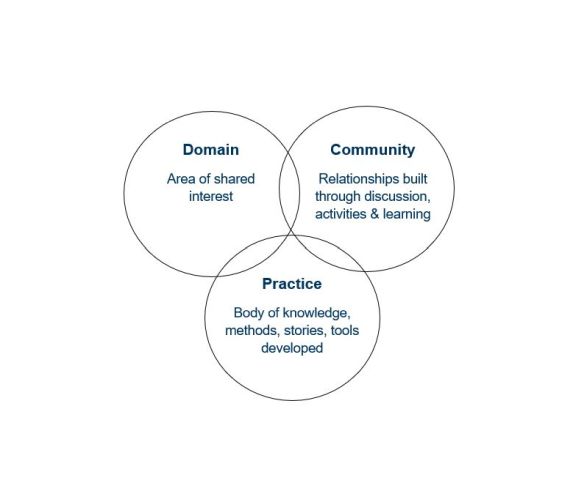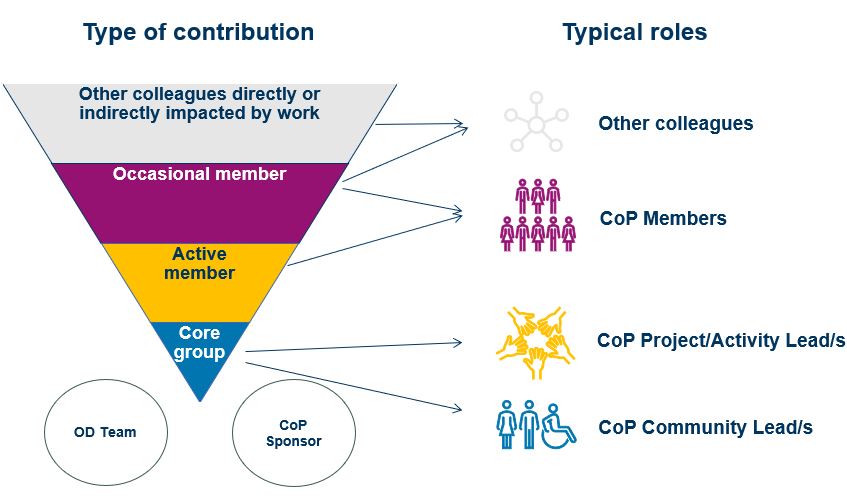What are CoPs and how do they work?
A Community of Practice or CoP is “a group of people who perform similar functions and share a concern or a passion for something they do and learn how to do it better as they interact regularly”.
The concept was developed by Etienne Wenger in the 1990s as part of social learning theory.
Useful links
Related resources
'What works in CoPs': Two projects (UofG and ODHE)
Communities of Practice Toolkit (ODHE)
Where to now?
How do CoPs work in practice?
Purpose
A group of people that share an interest and come together to fulfil shared goals
Membership
Voluntary: Colleagues self-select to participate and contribute
Organisation
CoPs can emerge or can be intentionally established. They can be self organising or supported by the organisation.
Activities
CoP identify priorities that are within/on the edge of the ‘sphere of influence’ of the community to progress and complete. These might be project based (usually with support from the Sponsor) or activities (share good practice/new ideas e.g. lunch & learn)
Sponsorship
A CoP Sponsor enables alignment where appropriate; promotes and celebrates success and; values CoP autonomy (they do not direct activity)
Critical Success Factors
Research by Organisational Development in Higher Education (ODHE) members carried out in 2021 identified the following critical success factors for CoPs:
- Executive sponsorship
- Alignment with institutional strategic goals
- Clarity of CoP purpose and vision
- Commitment to the reciprocity of peer learning
- Intention co-creation and nurturing values in the CoP
- Diverse CoP membership
- Regular CoP communications, meetings and calls to action
How are CoPs different from other groups?
A CoP is different from a network in the sense that it is “about” something; it is not just a set of relationships. It has an identity as a community, and as such. shapes the identities of its members.
A CoP exists because it produces a shared practice as members engage in a collective process of learning. The network aspect refers to the set of relationships, personal interactions, and connections.
|
|
What's the purpose? |
Who belongs? |
What holds it together? |
How long does it last? |
|---|---|---|---|---|
Community of practice |
To produce, extend and exchange knowledge and to develop members' capabilities |
Members who select themselves |
Passion, commitment and identification with the group's expertise |
As long as there is interest in maintaining the group, the subject and the learning |
Formal work group |
To deliver a product or service |
Everyone who reports to the group's manager |
Job requirements and common goals |
Until the next organisation |
Project team |
To accomplish a specific task |
Employees assigned by senior manager |
The project's milestones and goals |
Until the project has been completed |
Informal network |
To collect and pass on business information |
Friends and business acquaintances |
Mutual needs |
As long as people have reason to connect |
What are the benefits of participating in CoPs?
The following table highlights some of the for both members of the CoPs and the University:
Facilitate and enable non-directed personal & professional development |
Enhance and align strategic capability across the University |
|---|---|
|
|
At the end of our first 'cycle' of CoP activity at the University, we sought feedback from members on their experience of participating in CoPs. In both our Leadership & Management (L&M) Community and Project Management (PM) Community, 1 in 4 respondents said they had adapted or changed their practice after participating in learning events.
These experiences were also mirrored in research carried out in 'What works in CoPs': Two projects (UofG and ODHE)
What are the different types of contribution and roles in CoPs?
Active participation
There are many different ways in which members engage in their CoP. An active participant is likely to attend events or contribute to projects, build relationships, supporting colleagues and sharing experiences. Active participants usually represent 20% of the total membership.
Core Group
Some members want to contribute in a more purposeful way, leading projects, learning activities or communications, or even the CoP. These members are often passionate about the ‘domain’. They have often experienced real benefits from participating and look to give something back. These members form a Core Group who take responsibility for enabling the Community over a period time – usually a year.
Sponsorship
A CoP really benefits from Sponsorship. Critically the Sponsor respects the autonomy of the CoP so does not direct its work but helps to foster opportunities for strategic alignment and insight. They also play a critical role in championing the CoP and celebrating its success.
The following table describes the different elements of roles in a CoP.
| Sponsor | Community Lead/s | Project/Activity Lead/s |
Members (active or occasional) | |
|---|---|---|---|---|
| Purpose |
Tie the CoP and the benefits to the University’s strategic objectives |
Lead CoP and enable CoP organisation, communication and information sharing |
Lead projects/ activities (objectives) to enhance practice around priorities identified by members |
Participate and share knowledge and experiences. Contribute to prioritisation of projects/activities |
| Delivering objectives |
Work with CoP Lead/s to support Project/Activity Lead/s and any other roles identified. |
Support Project Leads and members in delivering objectives |
Enable team approach to delivery of objectives through members and other colleagues |
Contribute to problem solving and ideas generation |
| Celebrating impact |
Advocate acceptance and recognition for the community – promote success! |
Manage links with Sponsor on behalf of the CoP |
Lead and promote impact and continuous improvement in CoP |
Promote and contribute to continuous improvement in the CoP |
| Reviewing & Renewing |
Measure and evaluate the community’s contributions to University objectives |
Evaluate CoP and renewal |
Support evaluation of projects/activities and contribute to CoP evaluation and renewal |
Identify ways to enhance CoP effectiveness e.g. ways of working, promotion. |
| Resources |
Allocate budget and resources for the community |
Activities deployed by a Core Group |
|
|
What are typical activities undertaken in a CoP?
There are three different groups of activities that a CoP needs to deliver if it is to effectively establish and sustain itself:
Delivery
- Design & delivery of programme of learning e.g. lunch & learn
- Design & delivery of projects/activities
- Respond to opportunities
- Evaluate participation and impact
Decision making
- CoP planning process
- Enable feedback and reporting back on decisions
- Use evaluation data to enhance Community impact
- Enable alignment with Sponsor and other CoPs internally (& externally)
Communications
- Informal and formal comms internally & externally to CoP
- Launch event
- Raise awareness
- Promote activities
- Celebrate success



